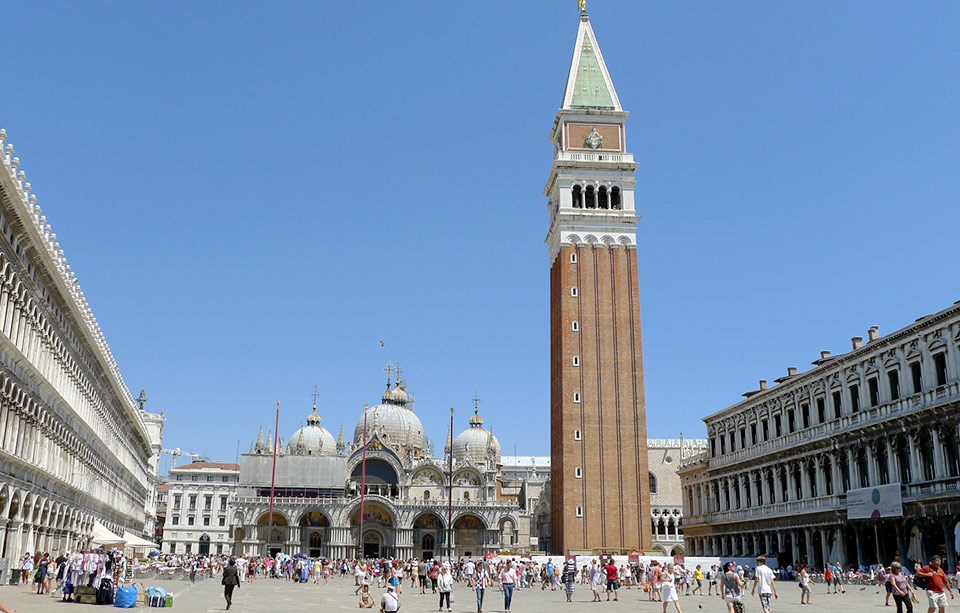St. Mark's Square, located in Venice, is one of the most important Italian squares, renowned throughout the world for its beauty and architectural composition.
It is the only urban area of Venice, which takes the name of the piazza, all other spaces in the form of square are properly defined like campi. It has a trapezoidal shape and is 170 meters long. The Piazza is dominated at its eastern end by the great church of St Mark. It will be described by a perambulation starting from the west front of the church (facing the length of the Piazza) and proceeding to the right. The church is described elsewhere but there are aspects of it which are so much a part of the Piazza that they must be mentioned here, including the whole of the west facade with its great arches and marble decoration, the romanesque carvings round the central doorway and, above all, the four horses which preside over the whole piazza and are such potent symbols of the pride and power of Venice.
The church is described elsewhere (see St Mark's Basilica) but there are aspects of it which are so much a part of the Piazza that they must be mentioned here, including the whole of the west facade with its great arches and marble decoration, the romanesque carvings round the central doorway and, above all, the four horses which preside over the whole piazza and are such potent symbols of the pride and power of Venice that the Genoese in 1379 said that there could be no peace between the two cities until these horses had been bridled and, four hundred years later, Napoleon, after he had conquered Venice, had them taken down and shipped to Paris.
One starts by crossing the Piazzetta dei Leoncini, an open space on the north side of the church named after the two marble lions (presented by Doge Alvise Mocenigo in 1722) on which children are often scrambling, but now officially called the Piazzetta Giovanni XXIII.
Beyond that is the Clock Tower, completed in 1499, above a high archway where the street known as the Merceria (a main thoroughfare of the city) leads through shopping streets to the Rialto, the commercial and financial centre. To the right of the clocktower is the closed church of San Basso, designed by Baldassare Longhena (1675), sometimes open for exhibitions.
Turning left and following the long arcade along the north side of the Piazza, the buildings on this side are known as the Procuratie Vecchie, the old procuracies, formerly the homes and offices of the Procurators of Saint Mark, high officers of state in the days of the Republic of Venice. They were built in the early 16th century. The arcade is lined with shops and restaurants at ground level, now with offices above. The restaurants include the famous Caffe Quadri, which was patronised by the Austrians when Venice was ruled by Austria in the 19th century, while the Venetians preferred Florian's on the other side of the Piazza.
Turning left at the end, the arcade continues along the west end of the Piazza, which was rebuilt by Napoleon about 1810 and is known as the Ala Napoleonica (Napoleonic Wing). It holds, behind the shops, a ceremonial staircase which was to have led to a royal palace but now forms the entrance to the Museo Correr (Correr Museum).
Turning left again, the arcade continues down the south side of the Piazza. The buildings on this side are known as the Procuratie Nuove (new procuracies), whch were designed by Jacopo Sansovino in the mid 16th century but partly built (1582-6) after his death by Vincenzo Scamozzi apparently with alterations required by the Procurators and finally completed by Baldassare Longhena about 1640. Again, the ground floor has shops and also the Caffè Florian, a famous cafe opened in 1720 by Floriano Francesconi. which was patronised by the Venetians when the hated Austrians were at Quadri's. The upper floors were intended by Napoleon to be a palace for his stepson Eugène Beauharnais, his viceroy in Venice, and now houses the Museo Correr. At the far end the Procuratie meet the north end of Sansovino's Libreria (mid-16th century), whose main front faces the Piazzetta and is described there. The arcade continues round the corner into the Piazzetta.
Opposite to this, standing free in the Piazza, is the Campanile of St Mark's church (1156/73 last restored in 1514), rebuilt in 1912 com'era, dov'era (as it was, where it was) after the collapse of the former campanile on 14 July 1902. Adjacent to the Campanile, facing towards the church, is the elegant small building known as the Loggetta, built by Jacopo Sansovino in 1537-46, and used as a lobby by patricians waiting to go into a meeting of the Great Council in the Doges Palace and by guards when the Great Council was sitting.
Across the Piazza in front of the church are three large mast-like flagpoles with bronze bases decorated in high relief by Alessandro Leopardi in 1505. The Venetian flag of St Mark used to fly from them in the time of the Republic of Venice and now shares them with the Italian tricolour.
The Piazza is usually thronged with tourists and photographers and extremely popular with pigeons.
Flooding
The Piazza San Marco is not far above sea level and during the Acqua Alta, the "high water" from storm surges from the Adriatic or heavy rain, it is quick to flood. Water pouring into the drains in the Piazza runs directly into the Grand Canal. This normally works well but, when the sea is high, it has the reverse effect, with water from the lagoon surging up into the Square.
Map of San Marco Square
